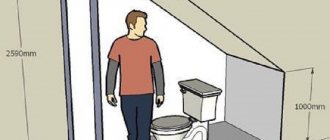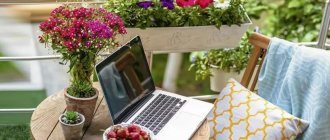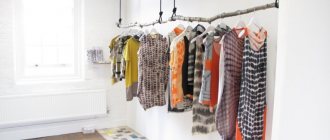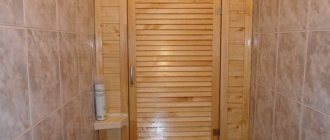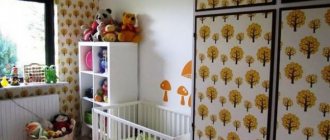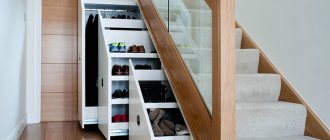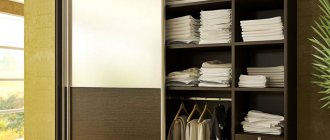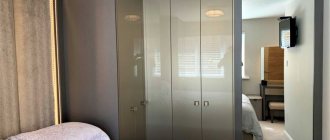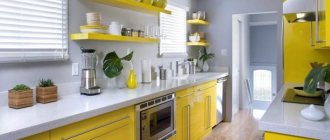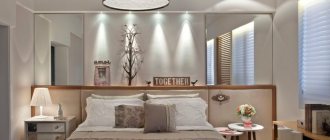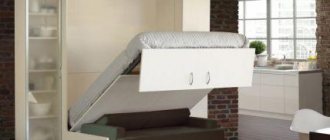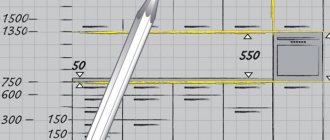Many owners of country cottages, multi-level townhouses, private houses and summer cottages are faced with the problem of arranging the space under the stairs indoors. It is a pity to lose part of the usable area if the room has a marching or screw structure with platforms and steps. To wisely use the free space, you can install a built-in cabinet under the stairs, made according to an individual project and drawing. Any construction and design ideas are available for implementation, so the owner wins doubly - he receives functional furniture and effectively uses the space under the stairs.
Features and purpose
Currently, built-in wardrobes mounted under a flight of stairs in a two-story cottage, multi-level room, or country house architecture are no longer considered an exotic design option and are considered common furniture items. Built-in structures organically complement the interior, effectively combining with the staircase and the decor of the room. The purpose of the furniture is the competent use of the free space under the stairs. At the same time, the cabinet located under the stairs is a functional design for the ergonomic use of furniture in everyday life. Features and advantages of original furniture:
- rational use of free space for compact installation of furniture for various purposes - library, mini dressing room, storage module, hallway, workplace;
- absence of unused and inconvenient areas - a cabinet made strictly according to the dimensions of the space under the stairs is distinguished by ergonomics and functionality;
- installation of a built-in type structure - installing a stationary model under the stairs is irrational, since the walls, roof, floor will take away useful centimeters of space;
- implementation of non-standard design solutions, the ability to mount a cabinet model of any design in an empty area under the stairs - sliding compartment, hinged, cabinet, cabinet, shelving;
- an aesthetically attractive addition to the interior of a room, the visual effect of a complete tandem of a cabinet and a staircase (flight, spiral, on rails or stringers);
- the versatility of the products in the living space - it is important to install cabinets under the stairs in a private house, cottage, townhouse, or country house.
Furniture companies manufacture cabinets based on individual customer designs after measuring the free space for installing the product. As an option, you can make a simple cabinet in the under-stairs area yourself - it’s easy to equip a rack with open shelves with your own hands. In built-in models, the load-bearing elements are the walls of the room, the roof is the stair steps, the bottom of the cabinet is the floor in the room, but you can install a separate slab made of modern particle board materials.
DIY cabinet under the stairs: stages of work
The work on arranging the space under the flight of stairs consists of several stages. Firstly, it is necessary to remove all foreign objects and dismantle existing partitions. If necessary, make a finished floor.
After this, begin developing a project for the future cabinet, clearly understanding its purpose. And also how it will look when finished.
What to consider when designing a cabinet layout
Firstly, the size of the cabinet directly depends on the configuration of the staircase and its functional purpose.
When drawing up a project for arranging the space under a flight of stairs, take into account the design concept of the room. So that the appearance of the cabinet does not introduce disharmony. But it fit organically into the overall design of the room. In addition, a lot depends on your imagination, wallet size and taste preferences.
Wardrobe under the stairs: arrangement options
There are many design options, choose according to your taste and wallet.
For example, a closet under the stairs with doors. Their height depends on their location.
The sliding wardrobe will fit perfectly into any interior. Its main advantage is its compact design and a wide range of external design options. But this is a rather difficult option to install, requiring certain skills and abilities. If you do not have these, then it is better to use the services of a specialist.
After preparing the space under the flight of stairs and drawing up a diagram of the closet, we proceed directly to the arrangement.
Required tools and required materials
Tools for work you will need:
- electric drill with a set of drills;
- electric screwdriver or set of screwdrivers;
- jigsaw or angle grinder, colloquially called a grinder;
- tape measure and pencil;
- and, of course, skillful hands.
The set of finishing materials depends on the design of the structure being created, the general design concept and financial capabilities. But you will definitely need:
- wooden blocks, at least 5x5 cm, from which the cabinet frame will be assembled:
- wood screws;
- necessary accessories: awnings, furniture handles, etc.
If drawers are intended, then furniture runners will be required. For a cabinet with doors, it is better to use piano furniture hinges.
Stages of work
If you are not a professional carpenter, then you should make a simple cabinet with open shelves. If you have certain skills, you can build a more complex structure.
The first stage of work is decorative finishing of the wall under the stairs. It's up to you to decide how to do it. Possible options:
- wallpapering;
- cladding with plasterboard, followed by decoration;
- covering with clapboard or other finishing materials;
- high-quality plaster and painting;
- MDF boards, etc.
Installation of internal partitions
Since the space under the stairs has different heights, internal partitions will be needed. For this purpose, you can use fiberboard or chipboard. You can make a frame from beams and cover it with plywood or plasterboard. Everything is securely fixed using self-tapping screws.
Internal partitions are decorated in the same style as the wall under the stairs.
We install shelves
After the internal partitions have been mounted and decorated, proceed to installing the shelves. Shelves can be made from natural planed and treated boards. Or from MDF boards, chipboard or fibreboard. Open shelves can be made of tempered tinted glass. Or from aluminum-based composite materials.
The fastening of the shelves depends on what material they are made of. Shelves made of wood or various slabs can be attached to wooden beams.
For glass and composite shelves you will need special furniture shelf holders or brackets.
Making doors
Special attention is paid to the manufacture of doors. Because doors are the main element that will help fit into the overall design of the room. If you are not a professional, then doors and frames should be ordered from specialists. Firstly, because they most often come in different sizes and configurations. Secondly, the master will make blanks that perfectly match your cabinet and design.
Door frames are usually fastened with self-tapping screws, and the platbands are “set” with a special construction adhesive.
The door leaf of swing doors is attached to the frame on hinges.
If you plan to install a wardrobe, you will need casters and furniture guide rails.
ATTENTION!!!
The facade of the cabinet should fit harmoniously into the design of the room. The option with mirrored doors will suit any style. Classic wood brings warmth and comfort to the interior. If you are a high-tech supporter, then install frosted glass cabinet doors.
Kinds
In a private house, cottage, or country house, two types of stairs are installed - marching stairs with straight flights of steps, intermediate platforms, and spiral ones, the design of which is made in a spiral around the supporting axis. Building a closet into the space of a spiral staircase is problematic - it’s easier to limit yourself to creating a small corner for relaxation with a compact table, installing a chest of drawers or a cabinet. Spiral structures are equipped with a main support on which degrees are hung. The staircase to the attic or floor looks attractive as an independent element of the interior, takes up little space, so cabinets are built under the flight steps. Main types of cabinets:
- compartment model - fits perfectly with all interior styles, takes up a minimum of free space. It is attractive that the doors can be finished with various types of facades, photo printing, sandblasting, or mirror panels can be used for decoration. The internal filling of the cabinet depends on the size of the space under the stairs. It is convenient to install compartments with a sliding door system under small and medium-turn staircases;
- a built-in wardrobe with hinged doors is the optimal solution for spacious rooms. When developing a project, you need to take into account the free space for opening doors. You can use this option to equip a hallway, equipping the furniture with a mirror, devices for storing outerwear, baskets for shoes, drawers for small items, accessories, key holders, stands for umbrellas, hats. If there is a small usable area, a storage room will be equipped here;
- a retractable wardrobe based on the principle of a spacious chest of drawers - furniture sections can be mounted in horizontal and vertical versions, as in the photo below. Structural elements (boxes with a beveled top) move on roller wheels, so they do not leave mechanical damage on the floor covering. In spacious retractable modules it is convenient to store large items, clothes, sports equipment (skates, skis, golf sets) or household appliances for cleaning;
- shelving with open shelves - often used to equip a library in the under-staircase space. Shelves of different sizes are built into the free niche, fixing the parts on the back and side walls. Open shelving looks natural in a home living room - you can use them to create a cozy corner with memorabilia, souvenirs, family photos, and books. It should be taken into account that dust settles faster on open shelves, so the rack needs to be cleaned frequently;
- a combined version of furniture is an interesting design solution that combines open sections with closed modules. Behind the doors in the high part of the closet it is convenient to store casual outerwear, and open shelves are suitable for placing original interior items - vases, figurines, fresh flowers and other things. If the internal space allows, a TV is built into the niche, and audio and video equipment is placed on the shelves, as in the photo presented.
The space under the stairs can be equipped with a cabinet for any purpose, the area under the steps can be equipped with a bar counter, and shelves for storing a wine collection. The main condition is that the furniture material, decorative fittings, and cabinet finishes must be combined with the staircase in style and color to create a solid structure that complements the interior of the room.
Coupe
Rack
Swing
Retractable
Facade decoration
What gives a closet its designer flair? Original design of facades, for the manufacture of which a variety of materials can be used. There is no need to make a case for a built-in wardrobe, but as an option, the staircase to the attic can be supplemented with a case model. The main materials used in furniture production are MDF and chipboard, less often - natural solid wood. You can implement and design facades in several options:
- mirror panels - visually expand the space of the room, look appropriate in the hallway or dressing room. Behind the mirrored doors you can hide hangers for outerwear, shoe racks, shelves for hats and accessories;
- facades with photo printing - using professional equipment, a design is applied to the base using laser engraving and ultraviolet printing technology. Photographic quality finishing gives images a realistic appearance;
- sandblasting on tinted glass. Very interesting design ideas - matte images that give the space near the stairs a luxurious and sophisticated look. Sandblasting designs are not erased and do not require complex care;
- glossy plastic facades - this design visually increases the room space and looks impressive in contrast with the floor and carpet. Plastic is affordable, facades are presented in a wide color palette;
- rattan or bamboo doors. The decoration is relevant for interiors in ethnic and oriental styles. The material is light and looks simple and natural. Rattan and bamboo can be incorporated into a minimalist interior style.
In addition, decorative leather is used to decorate the facades - it goes well with furniture made of natural wood. If the staircase to the attic is made in a simple style, with minimal decor, you can equip a modest storage room, and use vertical louvered sashes as façade panels. Such a cabinet looks inconspicuous under the stairs and does not focus attention on the niche under it.
The cabinet rack is equipped with open shelves, so all things and objects will be in sight. If you need to close some sections, it is preferable to install combined furniture.
Popular furniture design ideas are an open section and shelves with curves, a middle compartment, a compartment with a hinged door or a pull-out drawer with a decorative panel. You can choose any design for the cabinet under the stairs, but the decoration of the facades should be in harmony with the design of the steps, the rest of the furniture, and the style of the room.
Glossy
Mirror
Photo printing
Installation technology for built-in wardrobes
Before making a closet under the stairs, you need to measure the space under it and determine how many compartments the built-in closet will have, the height of each of them, the type of drawers and shelves.
It is better to depict all the data on paper in the form of a diagram with marked marks for installing partitions and doors.
Figure 2. Layout of cabinets under the stairs.
To install shelves under the stairs you will need:
- wooden block 5x5 cm;
- Fiberboard, plywood, plasterboard or other sheet materials;
- furniture facade, laminated chipboard, etc. for doors or panels;
- fittings for installing drawers, hinges, mechanisms for sliding doors;
- electric saw or hacksaw;
- drill, screwdriver;
- plumb line and level, measuring tool.
The frame for the shelves and partitions will be made of a 5x5 cm bar. Based on the height of the side walls of each compartment, cut the material into paired parts of the required length for mounting vertical supports. Rice. 2. Fasten the bars closest to the wall using dowels in brickwork or concrete, and for a wooden surface, nails or self-tapping screws of sufficient length are suitable. Install internal partitions by attaching a block to the bottom of the steps at the top and to the floor at the bottom.
Figure 3. Cabinet assembly.
Related article: DIY fleece sleeping bag for a newborn
Attach horizontally located pieces of timber to the installed vertical supports. Their length is equal to the depth of the shelves or cabinet compartments. Some of them are usually used as a base for attaching shelves or drawer fittings, so the distance between the bars must be selected depending on the height of each tier.
Sheathe the prepared frame from the inside with selected sheet material (plywood, plasterboard, etc.), forming partitions. If you planned to build an open shelving, then at this stage you can already move on to finishing the internal surfaces of the cabinet and installing shelves.
If the built-in cabinet needs to have doors or drawers, the work will continue. A sliding wardrobe under the stairs will require complex operations to install the mechanism for doors of different heights. To carry out such work efficiently, the best solution would be to invite a professional specialist.
How to fit into the interior
The staircase to the attic or second floor, depending on the size of the room, can be located along one of the walls, start in the central part of the room, and have turns and curves. The easiest way is to install a cabinet under the stairs, located along the wall - you can install a lightweight structure that complements the flights of stairs. The main advantage of using the space under the stairs is that interior elements can be made invisible or, on the contrary, attention can be focused on an interesting idea for decorating a room. Depending on the room and building in which you need to equip the space under the stairs, you can choose several ways to harmoniously fit the closet:
- if the staircase to the attic, second or third floors is located near the entrance doors, it is worth installing a hallway or dressing area with storage systems under the steps. The room will not have to be additionally equipped with furniture with hangers for outerwear, shoe shelves, hooks for umbrellas, bags;
- when the stairs to the upper floors are located in the living room, the space under the stairs is convenient to use for arranging an open library shelving with bookshelves, a wine library, a “souvenir” shop, and a relaxation area with a TV. Option - a combined cabinet with several closed sections;
- in a narrow under-staircase space, it is appropriate to install deep and tall retractable cabinets under the stairs, equipped with Cargo extension mechanisms, as an inconspicuous pantry for storing bulky items and items that are needed every day - children's toys, sports equipment, ironing board;
- In modern two-level apartments, a staircase is a mandatory attribute. The first tier is traditionally used as a living room, kitchen, and dining area, while the second level is used for sleeping and working space. Under the stairs you can effectively fit a cupboard or furniture with a bar counter into the interior;
- at the dacha the area of the rooms is limited, the staircase to the attic (attic) or second floor is small, has a simple design, and the interior is dominated by country, retro, Provence, classic, less often loft, modern, minimalism. It is important to use the free space under the stairs for a cabinet with antique surroundings.
Furniture design depends on both the interior style and the house as a whole. For example, in a country villa, the staircase serves as a decoration of the building; it is better to fit a chic wardrobe, a rich library, furniture with glass display cases and shelves for a collection of expensive wine under it. In small country houses, small-sized cottages of standard architecture, the space under the stairs is used to optimize free space - more often they install inconspicuous cabinets, simple open shelving, secret pantries, and dressing rooms.
When choosing the color of a single design, the cabinet stairs to the second floor are based on the design of the railings and steps. In some cases, deep horizontal drawers are installed, which serve as a natural structural continuation of the winder steps and do not stand out against the general background. You can fit a cabinet correctly into any interior style, simultaneously solving two problems - using the empty space under the stairs and effectively decorating the room.
Placement nuances
An important advantage of equipping a room with a cabinet under the stairs is the optimal spaciousness of the furniture, since the depth of the model corresponds to the width of the stair steps, and the height at the maximum point is at least 950 mm. These sizes are quite suitable for organizing storage systems for bulky items, clothing, shoes, household appliances or for creating a decorative corner with an aquarium, souvenir shelves, TV, mini bar, and wine library. To correctly design and place a cabinet under the stairs, you need to take into account several nuances:
- When using a sliding door opening system, it is necessary to provide enough space for the panel to move along the lower or upper guides. In some designs, it will not be possible to open the doors completely, so there will be unused areas in the cabinet;
- When installing a built-in wardrobe with hinged doors, the width of the doors should not exceed 1000 mm. The weight of the heavy panel causes the hinges to become distorted and the opening/closing mechanisms to fail. It is inconvenient to use a wide swing door - it is better to install two small doors;
- When placing drawers under the stairs, you need to ensure their full extension to access the rear wall of the space under the stairs - this is especially important if communication systems run under the stairs. Vertical boxes are equipped with Teflon-coated rollers - they have a long service life;
- When installing an open shelving cabinet, you need to combine shelves in height and width in order to place objects of different sizes on them. The shelves are installed into the wall and to the steps, so the base is made strong and the finishing is done. The weight of shelves filled with things should moderately load the stairs;
- An alternative solution is to install a compact-sized cabinet staircase, suitable for arranging a flight of stairs that is small in height and length. The steps simultaneously serve as the roof of the furniture structure; durable materials are used for their manufacture, for example, boards or natural wood.
There are a lot of interesting ideas for equipping the under-staircase space. In addition to installing a closet, you can design a separate room under the steps - a playroom for children, a study, a relaxation lounge with a comfortable sofa.
Sometimes the space under the stairs is used to install washing machines inside the cabinet, but care should be taken to supply communications and constantly ventilate the area under the stairs. A variety of design solutions allows you to rationally use the unused space under the stairs and add bright accents to the interior.
Ideas and creative solutions for cabinets under the stairs
“Glass showcase”
A rare way of design. Allows you to visually liberate the heaviness of the steps. Handmade collections, valuables, and expensive dishes are stored in such places. LED trim adds an element of style.
The glassed space is not only protected from dust, but also has a certain humidity level for valuable exhibits.
“Kitchen under the stairs”
A work area under the stairs in the form of a mini kitchen will save space.
pros:
- Save space for other rooms
- Availability of everything you need: stove, sink, countertop, refrigerator.
Minuses:
- Household appliances with minimal dimensions.
- Lack of natural light.
- Lamps.
Organizing a compact room under the stairs
The rest room under the stairs looks original. A small sofa, an elegant night light, a shelf with your favorite books.
